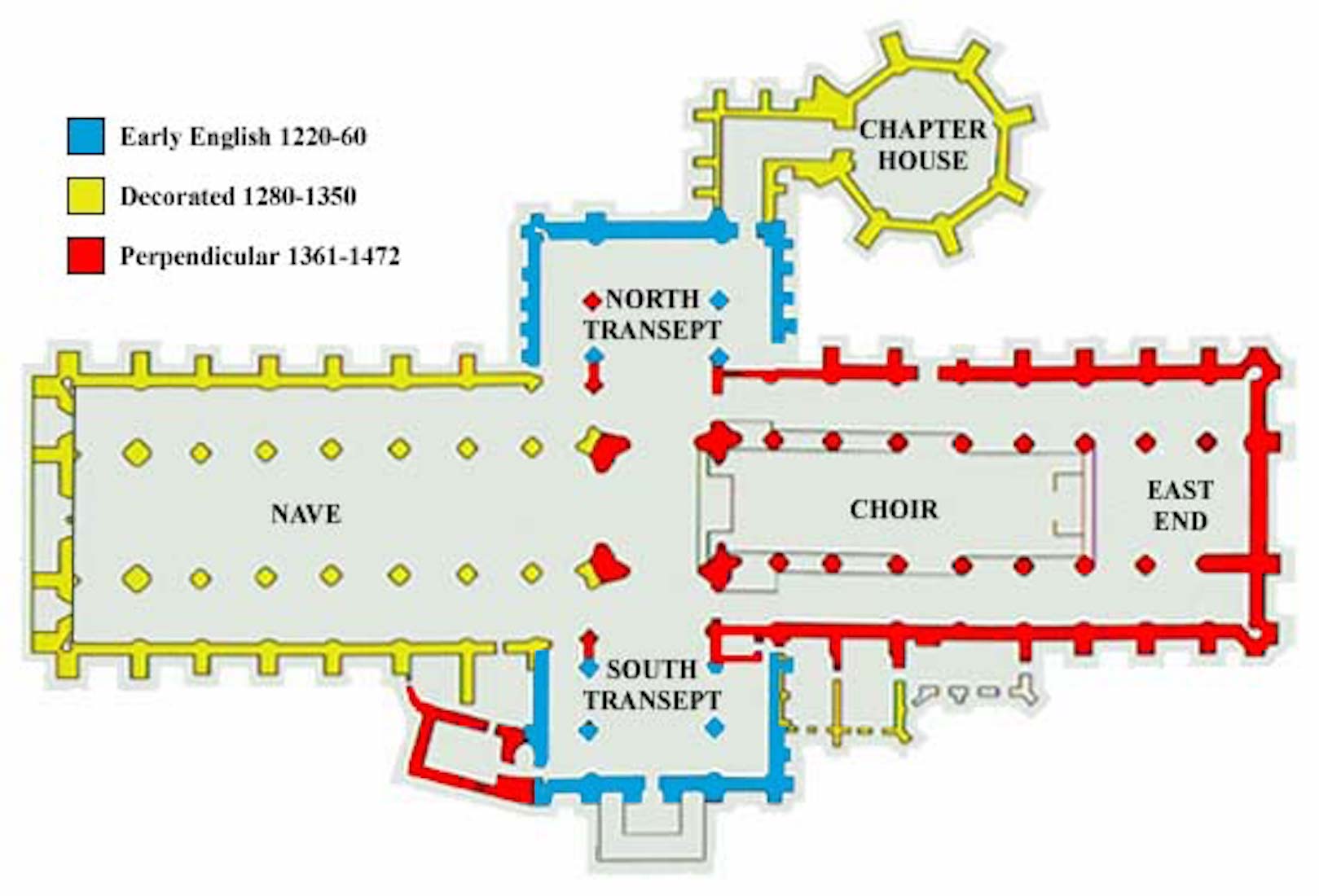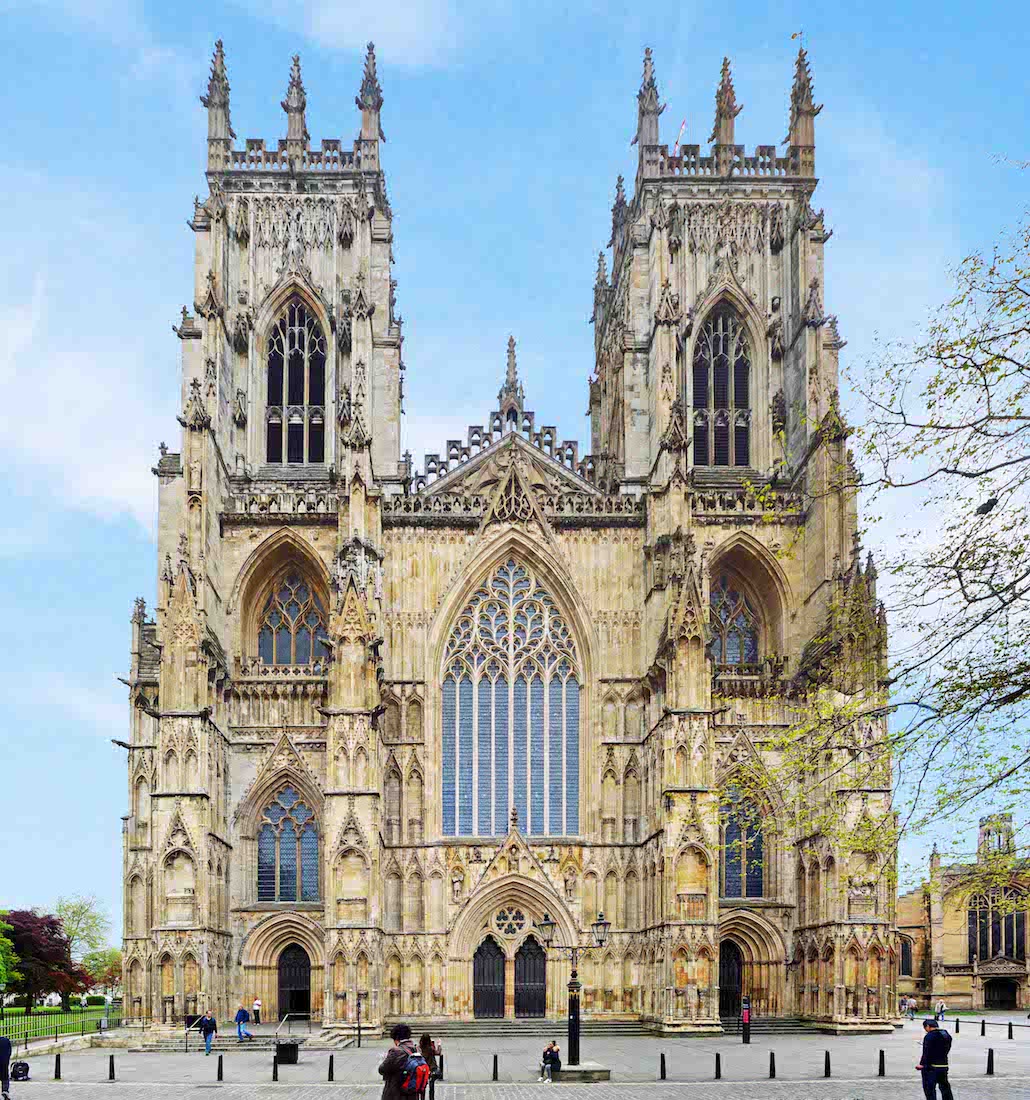WELCOME TO
YORK MINSTER
YORKSHIRE, ENGLAND
PAUL SCOTT

York Minster has a relatively straightforward plan, being cruciform in shape with a chapter house linked to the North transept. The Minster is oriented with its sanctuary facing due east geographically, so the liturgical and geographical directions coincide.
We shall begin at the West end, and walk around the outside in a clockwise direction before exploring the interior. This is time-consuming as there are many items of interest. We finish by looking at the crypt and undercroft, and climbing the tower!
A history of the Cathedral is given below. However, if you want to begin your tour of the Cathedral immediately, tap / click on START . You can also access intermediate points in the tour by a tap / click on the following links:
NOTE ON MAGNIFYING IMAGES
With this website format the images are large enough for most purposes. If there is a need for greater magnification of an image, go to the identical photo on
https://www.flickr.com/photos/paulscottinfo/albums
and use Command - + (Mac) or Windows - + (Windows).
HISTORY
[Wikipedia]
The Cathedral and Metropolitical Church of Saint Peter in York, commonly known as York Minster, is the Cathedral of York, England, and is one of the largest of its kind in Northern Europe. The minster is the seat of the Archbishop of York, the third-highest office of the Church of England (after the monarch as Supreme Governor and the Archbishop of Canterbury), and is the mother church for the Diocese of York and the Province of York. [3] It is run by a dean and chapter, under the Dean of York. The title ‘minster’ is attributed to churches established in the Anglo-Saxon period as missionary teaching churches, and serves now as an honorific title. Services in the minster are sometimes regarded as on the High Church or Anglo-Catholic end of the Anglican continuum.
The minster was completed in 1472 after several centuries of building. It is devoted to Saint Peter, and has a very wide Decorated Gothic nave and chapter house, a Perpendicular Gothic quire and East end and Early English North and South transepts. The nave contains the West Window, constructed in 1338, and over the Lady Chapel in the East end is the Great East Window (finished in 1408), the largest expanse of medieval stained glass in the world. In the North transept is the Five Sisters Window, each lancet being over 53 feet (16. 3 m) high. The South transept contains a rose window, while the West Window contains a heart-shaped design colloquially known as The Heart of Yorkshire.
History
A bishop of York was summoned to the Council of Arles in 314 indicating the presence of a Christian community in York at this time; however, archaeological evidence of Christianity in Roman York is limited. The first recorded church on the site was a wooden structure built hurriedly in 627 to provide a place to baptise Edwin, King of Northumbria. Moves toward a more substantial building began in the 630s. A stone structure was completed in 637 by Oswald and was dedicated to Saint Peter. The church soon fell into disrepair and was dilapidated by 670 when Saint Wilfrid ascended to the See of York. He repaired and renewed the structure. The attached school and library were established and by the 8th century were some of the most substantial in Northern Europe.
In 741, the church was destroyed in a fire. It was rebuilt as a more impressive structure containing thirty altars. The church and the entire area then passed through the hands of numerous invaders, and its history is obscure until the 10th century. There were a series of Benedictine archbishops, including Saint Oswald of Worcester, Wulfstan and Ealdred, who travelled to Westminster to crown William in 1066. Ealdred died in 1069 and was buried in the church.
The church was damaged in 1069 during William the Conqueror’s harrying of the North, but the first Norman archbishop, Thomas of Bayeux, arriving in 1070, organised repairs. The Danes destroyed the church in 1075, but it was again rebuilt from 1080. Built in the Norman style, it was 111 m (364. 173 ft) long and rendered in white and red lines. The new structure was damaged by fire in 1137 but was soon repaired. The choir and crypt were remodelled in 1154, and a new chapel was built, all in the Norman style.
The Gothic style in Cathedrals had arrived in the mid 12th century. Walter de Gray was made archbishop in 1215 and ordered the construction of a Gothic structure to compare to Canterbury; building began in 1220. The North and South transepts were the first new structures; completed in the 1250s, both were built in the Early English Gothic style but had markedly different wall elevations. A substantial central tower was also completed, with a wooden spire. Building continued into the 15th century.
The Chapter House was begun in the 1260s and was completed before 1296. The wide nave was constructed from the 1280s on the Norman foundations. The outer roof was completed in the 1330s, but the vaulting was not finished until 1360. Construction then moved on to the eastern arm and chapels, with the last Norman structure, the choir, being demolished in the 1390s. Work here finished around 1405. In 1407 the central tower collapsed; the piers were then reinforced, and a new tower was built from 1420. The western towers were added between 1433 and 1472. The Cathedral was declared complete and consecrated in 1472.
The English Reformation led to the looting of much of the Cathedral‘s treasures and the loss of much of the church lands. Under Elizabeth I there was a concerted effort to remove all traces of Roman Catholicism from the Cathedral; there was much destruction of tombs, windows and altars. In the English Civil War the city was besieged and fell to the forces of Cromwell in 1644, but Thomas Fairfax prevented any further damage to the Cathedral.
Following the easing of religious tensions there was some work to restore the Cathedral. From 1730 to 1736 the whole floor of the minster was relaid in patterned marble and from 1802 there was a major restoration. However, on 2 February 1829, an arson attack by Jonathan Martin inflicted heavy damage on the East arm. An accidental fire in 1840 left the nave, Southwest tower and South aisle roofless and blackened shells. The Cathedral slumped deeply into debt and in the 1850s services were suspended. From 1858 Augustus Duncombe worked successfully to revive the Cathedral. In 1866, there were six residentiary canonries, of which one was the Chancellor’s, one the Sub-Dean’s, and another annexed to the Archdeaconry of York.
During the 20th century there was more concerted preservation work, especially following a 1967 survey that revealed the building, in particular the central tower, was close to collapse. £2,000,000 was raised and spent by 1972 to reinforce and strengthen the building foundations and roof. During the excavations that were carried out, remains of the north corner of the Roman Principia (headquarters of the Roman fort, Eboracum) were found under the South transept. This area, as well as remains of the Norman Cathedral, re-opened to the public in spring 2013 as part of the new exhibition exploring the history of the building of York Minster.
1984 fire
On 9 July 1984, York Minster suffered a serious fire in its South transept during the early morning hours. Firefighters made a decision to deliberately collapse the roof of the South Transept by pouring tens of thousands of gallons of water onto it, in order to save the rest of the building from destruction. A total of 114 firefighters from across North Yorkshire responded to the fire and contained it, while York Minster’s staff and clergy rushed to preserve historical objects in the building. The glass of the South Transept rose window was shattered by the heat but the lead held it together, allowing it to be taken down for restoration. A subsequent investigation found an 80% chance that the fire was caused by a lightning strike to a metal electrical box atop the roof, a 10% chance that the fire was caused by arson, and a 10% chance that the fire was caused by an electrical fault. Some traditionalist Anglicans suggested the fire was a sign of divine displeasure at the recent consecration as Bishop of Durham of David Jenkins, whose views they considered heterodox.
A repair and restoration project was completed in 1988 at a cost of £2.25 million,[16] and included new roof bosses to designs which had won a competition put on by BBC Television's Blue Peter programme for children. The roof trusses were rebuilt in oak, but some were coated with fire-retardant plaster.
2007–2018 renovation
In 2007 renovation began on the East front, including the Great East Window, at an estimated cost of £23 million. The 311 glass panels from the Great East Window were removed in 2008 for conservation. The project was completed in 2018.



